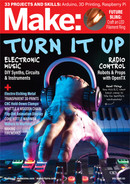
G
rowing up in the UK, the BBC’s Computer
Literacy Project gave me the once-in-a-
century chance to take a front-row seat in the
computer revolution. At my school in Essex
there was a single BBC Micro Model B in our
classroom, which we were only allowed to use
occasionally, and usually as a group.
The BBC Micro was the creation of Arm
progenitor Acorn Computers, and its innovative
“Tube” interface allowed the Acorn team to
use it as a test mule while developing their
next-generation RISC (Reduced Instruction Set
Computer) silicon and associated software. The
resultant 6MHz ARM1 (Acorn RISC Machine)
chip was then dogfooded as a second processor
for the BBC Micro, where it helped enable
simulation, accelerate CAD work, and provide a
target for a new version of BBC BASIC written in
ARM assembly.
One day my father came home with Acorn’s
latest BBC Master 128, the successor to the
venerable Model B, with which I cherished every
fleeting moment. Thus began my life with Arm,
though I hadn’t quite realized it yet.
I recall vividly the first time I truly encountered
Arm; Dad took me to a computer show where I
saw, on a pedestal, the 32-bit, ARM2-powered
Acorn Archimedes. The machine and several
others like it were running a 3D spaceship
lander (aka Zarch) and a real-time rendering of
colored spheres to demonstrate the machine’s 7x
performance advantage over already impressive
68000-based contemporaries like the Amiga.
Not long after, I moved to the USA and the
remainder of my formative years were spent
surrounded by x86-based PCs, which never
caught my passion in the same way as the Acorn
devices, but saw me attending the University
of Michigan Honors College to study Computer
Science, and securing internships at Microsoft.
It wasn’t until 2007 that I rediscovered my
path to all things Arm. Falling in love with the
Arduino Diecimila as part of a Roomba hacking
project enamored me with embedded hardware.
Rather than writing code to run on a screen or
web server, it allowed me to write code that I
could touch. The pinnacle of this was hacking on
the Arm Cortex-M4-based Pebble smartwatch
at the Pebble Rocks Boulder hackathon, which
combined my passion for the unique wearable
platform with my hardware obsession. The dev
targets we used during the event were PJRC’s
Teensy boards, another Cortex-based device,
meaning my team’s win was thanks in part to two
Arm-based chips!
With the kickoff of the Arm Developer
Program, this year is shaping up to be a very
exciting time to build on Arm. As an Arm
Ambassador within the program, I get extensive
support and insights directly from Arm experts,
while the wider-reaching Arm Developer
Program offers comprehensive resources for new
and experienced developers.
Whether you’re just starting out with
embedded machine learning, trying to optimize
your cloud computing performance and spend, or
pushing the realms of mobile graphics or server
performance, the Arm ecosystem is the place to
be in 2023. Join me for the next once-in-a-century
opportunity to develop the future on Arm.
Manuel Lucio Dallo
A LIFE WITH
Written by David J. Groom, Arm Developer Program Ambassador and Community Editor, Make:
Learn more about the
Arm Developer Program at
arm.com/developerprogram
Advertorial
M85_009_AD_Arm_F1.indd 1M85_009_AD_Arm_F1.indd 1 4/11/23 1:31 PM4/11/23 1:31 PM
..................Content has been hidden....................
You can't read the all page of ebook, please click here login for view all page.
